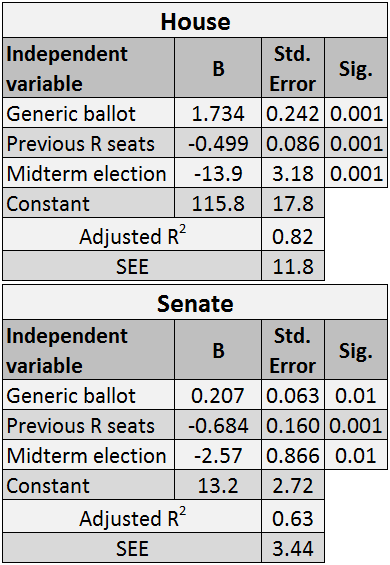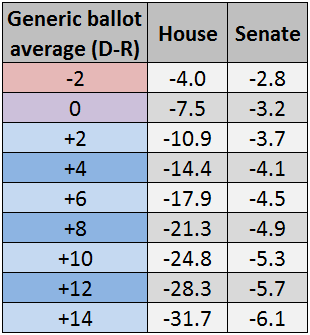Generic Ballot Forecasting Model: Democrats Could Take Back Senate but Republicans Likely to Hold House With Reduced Majority
A Commentary By Alan I. Abramowitz
Since the conclusion of the Republican and Democratic national conventions last month, pundits, political reporters, and ordinary Americans have, for understandable reasons, been preoccupied with developments in the presidential campaign. And the contest between Hillary Clinton and Donald Trump has certainly provided plenty of material for serious political observers as well as late night comics. With the presidential contest getting so much coverage in the national media, however, much less attention has been devoted to the critical battle for control of the next Congress. Regardless of the outcome of the presidential election, whether Republicans or Democrats control the House and Senate will have enormous consequences for the direction of the country and the ability of the next president to carry out his or her agenda.
At present, Republicans hold a 247 to 186 seat majority in the House of Representatives (with vacancies in two formerly Democratic-held seats that the party will easily hold onto). All 435 House seats and 34 of the 100 Senate seats are up for election this year. In reality, however, only around 50 House seats and perhaps a dozen Senate seats are really in play — the rest are completely safe for one party or the other. Nevertheless, there are enough seats in play that there is some uncertainty about which party will end up in control of the House and a great deal of uncertainty about which party will end up in control of the Senate.
So what should we expect in the House and Senate elections this year? A simple forecasting model based on three predictors — the number of Republican seats at stake in the election, support for the two major parties on the “generic ballot” question in national polls, and whether it is a midterm election under a Democratic or Republican president — yields fairly accurate predictions of seat swing in the House and Senate. The number of Republican seats at stake is a measure of exposure to risk: the more seats Republicans have at stake, the more seats they are likely to lose. The generic ballot, based on polls asking voters whether they would prefer a Democratic or Republican candidate for the U.S. House without naming the actual candidates, is an indicator of the national political climate. Finally, the midterm election variable indicates whether an election is a Republican or Democratic midterm. There is a strong tendency for the party holding the White House to lose seats in midterm elections. However, 2016 is a presidential election year, so the midterm variable is not relevant.
Table 1: Results of regression analyses of House and Senate election outcomes, 1946-2014
Notes: Dependent variable is change in Republican seats; SEE = standard error of estimate. No generic ballot data available for 1948.
Sources: Data compiled by author
Prediction equations for 2016 are presented in Table 1. The estimated weights for the three predictors and intercepts (constants) are based on OLS regression analyses of data on U.S. House and Senate elections between 1946 and 2014. The results indicate that for both House and Senate elections, all three predictors have substantial and highly statistically significant effects. As expected, seat exposure has large and highly significant negative effects on seat swing in both House and Senate elections, the generic ballot variable has substantial and highly significant effects in both types of elections, and the midterm variable has large and highly significant effects in the expected direction in both types of elections. However, while all three predictors have strong and statistically significant effects for both types of elections, the model is much more accurate for House elections than for Senate elections, explaining about 82% of the variance in House seat swing compared with only about 63% of the variance in Senate seat swing. This is exactly what one would expect given the much smaller number of Senate seats at stake in each election and the larger proportion of competitive Senate races.
Conditional Forecasts
Two of the three predictors in this model are already set for the 2016 election. We know that Republicans will be defending 247 of 435 House seats and 24 of 34 Senate seats this year, and we know that 2016 is a presidential election year so the midterm variable does not favor either party. The only unknown for 2016 is the value of the generic ballot variable. Table 2 therefore presents conditional forecasts for House and Senate seat change based on values for the generic ballot variable ranging from a two-point Republican lead to a 14-point Democratic lead.
Table 2: Conditional forecasts of change in Republican seats in House and Senate
Sources: Table 1 and data compiled by author
The results in Table 2 indicate that for almost any conceivable values of the generic ballot variable, Democrats are likely to make gains in both the House and Senate. That is largely due to the fact that, as a result of their successes in the 2010 and 2014 midterm elections, Republicans are defending unusually large numbers of seats in both chambers this year. However, the results indicate that in order for Democrats to gain the minimum of four seats they need to regain control of the Senate (if there is a Democratic vice president to break a 50-50 tie), they probably would need a lead of at least two or three points on the generic ballot and to gain the minimum of 30 seats they need to regain control of the House, they probably would need a lead of at least 13 points on the generic ballot.
According to HuffPost Pollster, results of recent national polls give Democrats an average lead of five points on the generic ballot. If that lead were to hold up until the week after Labor Day, the traditional cutoff date for the generic ballot forecast, Democrats would be expected to gain about 16 seats in the House and about four seats in the Senate — not enough to flip control of the House but enough to flip control of the Senate if Clinton wins the presidential election.
Of course any forecasts based on a statistical model are subject to a margin of error. In this case, the results in Table 1 indicate that if Democrats maintain a five-point lead in the generic ballot, they would be very likely to pick up between six and 26 seats in the House and between two and six seats in the Senate. They would have about a 50% chance of regaining control of the Senate (if there is a Democratic vice president) but less than a 15% chance of regaining control of the House.
Courtesy of Larry Sabato's Crystal Ball
See Other Commentary by Dr. Alan Abramowitz
Rasmussen Reports is a media company specializing in the collection, publication and distribution of public opinion information.
We conduct public opinion polls on a variety of topics to inform our audience on events in the news and other topics of interest. To ensure editorial control and independence, we pay for the polls ourselves and generate revenue through the sale of subscriptions, sponsorships, and advertising. Nightly polling on politics, business and lifestyle topics provides the content to update the Rasmussen Reports web site many times each day. If it's in the news, it's in our polls. Additionally, the data drives a daily update newsletter and various media outlets across the country.
Some information, including the Rasmussen Reports daily Presidential Tracking Poll and commentaries are available for free to the general public. Subscriptions are available for $4.95 a month or 34.95 a year that provide subscribers with exclusive access to more than 20 stories per week on upcoming elections, consumer confidence, and issues that affect us all. For those who are really into the numbers, Platinum Members can review demographic crosstabs and a full history of our data.
To learn more about our methodology, click here.



